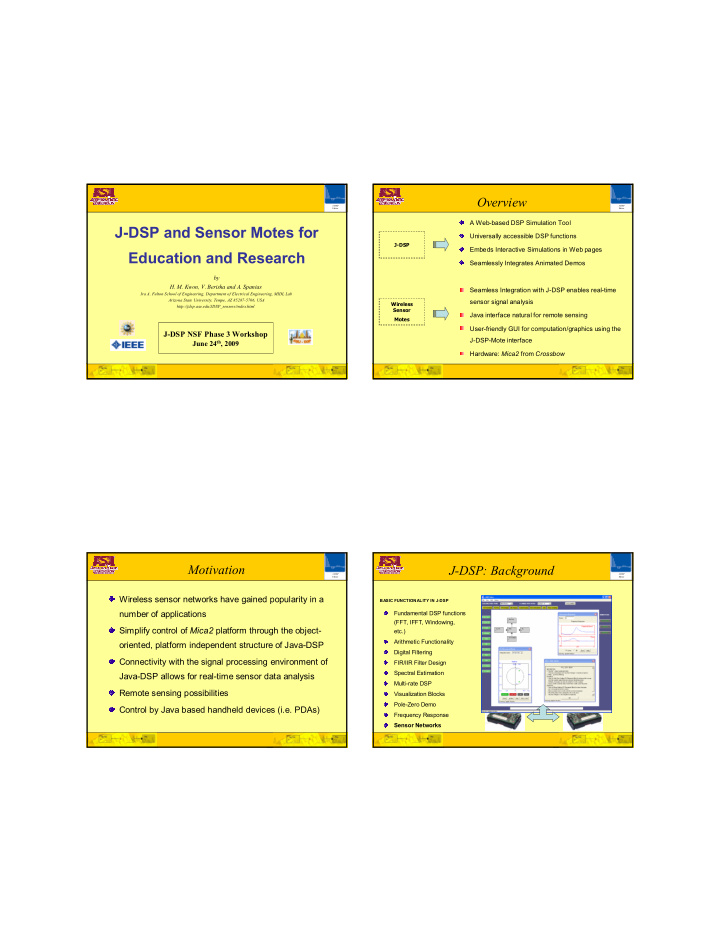



Overview J-DSP J-DSP Editor Editor A Web-based DSP Simulation Tool J-DSP and Sensor Motes for Universally accessible DSP functions J-DSP Embeds Interactive Simulations in Web pages Education and Research Seamlessly Integrates Animated Demos by H. M. Kwon, V. Berisha and A. Spanias Seamless Integration with J-DSP enables real-time Ira A. Fulton School of Engineering, Department of Electrical Engineering, MIDL Lab Arizona State University, Tempe, AZ 85287-5706, USA sensor signal analysis Wireless http://jdsp.asu.edu/JDSP_sensors/index.html Sensor Java interface natural for remote sensing Motes User-friendly GUI for computation/graphics using the J-DSP NSF Phase 3 Workshop J-DSP-Mote interface June 24 th , 2009 Hardware: Mica2 from Crossbow 1 2 Motivation J-DSP: Background J-DSP J-DSP Editor Editor Wireless sensor networks have gained popularity in a BASIC FUNCTIONALITY IN J-DSP number of applications Fundamental DSP functions (FFT, IFFT, Windowing, Simplify control of Mica2 platform through the object- etc.) Arithmetic Functionality oriented, platform independent structure of Java-DSP Digital Filtering Connectivity with the signal processing environment of FIR/IIR Filter Design Spectral Estimation Java-DSP allows for real-time sensor data analysis Multi-rate DSP Remote sensing possibilities Visualization Blocks Pole-Zero Demo Control by Java based handheld devices (i.e. PDAs) Frequency Response Sensor Networks 3 4
Hardware Platform Java-DSP and the Motes J-DSP J-DSP Editor Editor “ Collaborative Sensor Signal P D S P J - S J - D Internet Processing enabled by J-DSP ” MIB(510) Gateway : serial port programmer J-DSP • Targeted Applications: Environmental Monitoring, Security, Source Localization, Tracking, Biological Applications 5 6 Tiny OS and Java-DSP Tiny OS & nesC J-DSP J-DSP Editor Editor Java-DSP acts as an additional layer at the base station • Simple and powerful OS for low power Lower layer processing is seamless to the user • Re-use of component • “ Hurry up and sleep ” Tiny OS • Scheduling based on events and tasks J-DSP • FIFO structure BS Application • TinyOS syntax and structure • Dialect of C language nesC • A pre-processor Language – Converts wiring of high level modules into efficient code – nesC output is a c program file that is compiled and linked using gnu-gcc tools for a specific Mote Wireless Channel 7 8
The Motes (MICA2 Platform) The MOTE Block J-DSP J-DSP Editor Editor Plot Area • Microprocessor: Atmel ATmega 128L GUI for the motes – 7.3728 MHz clock Control panel is used – 128 kB of Flash for program memory – 4 kB of SRAM for data and variables to control the individual – 2 UARTs – Serial Pot Interface (SPI) bus motes and the RS232 – Inter IC (I2C) bus settings • Radio: Chipcon ’ s CC1000 • External serial flash memory: 512 kB MOTE block in J-DSP • 51-pin expansion connector allows users to control – Eight 10-bit analog I/O individual motes – 21 general purpose digital I/O • User interface: 3 LEDs Real-time graph plots • JTAG port data as it comes • Powered by two AA batteries – 1850 mAh capacity Control Panel 9 10 Sensor Network Signal Processing Remote Sensing with J-DSP with J-DSP J-DSP J-DSP Editor Editor A number of advanced Preliminary example signal processing features shows possibilities for available in J-DSP sensing and security applications You can connect the incoming data to existing Display panel shows blocks to create DSP which sensors are active systems Active Sensors: Example: Fitting incoming Light data to an auto-regressive Sound model Temperature Accelerometer 11 12
Future Directions Summary J-DSP J-DSP Editor Editor Simulation modules and blocks in J-DSP have been J-DSP and Motes for Research J-DSP and Motes for Education developed to control the Crossbow Motes Source localization using the Train UG and grad. students the Motes basics of working with wireless Object-oriented structure of J-DSP allows for easy Motes using the J-DSP GUI Target tracking manipulation of the Motes Train engineers and Interfacing with advanced J- Please visit http://jdsp.asu.edu for more information on practitioners in real-time DSP features (i.e. HMM) J-DSP analysis of sensor data Collaborative remote sensing J-DSP also supports: Statistical DSP simulations, Use hands-on hardware/ using J-DSP software approach to create a Communications, Speech analysis-synthesis, 2D and Image Implement sensor networks workforce trained in using using J-DSP/Motes for smart processing, Spectrogram/time-frequency experiments, and sensors for security and other home and security applications Controls simulations applications Some figures taken from http://www.xbow.com 13 14
Recommend
More recommend